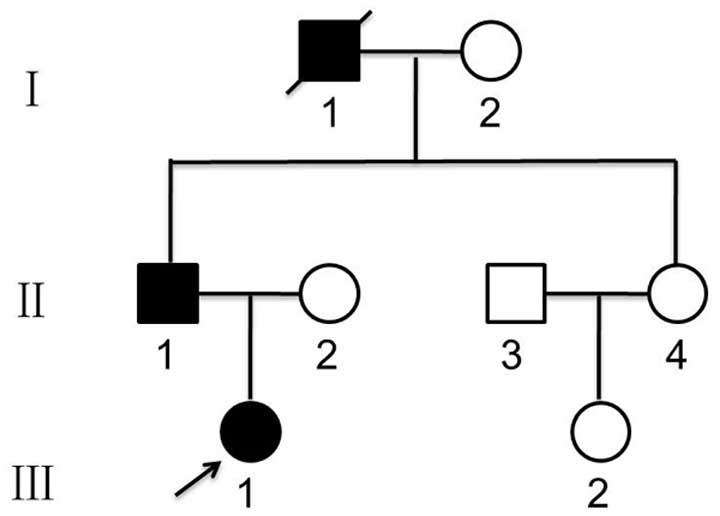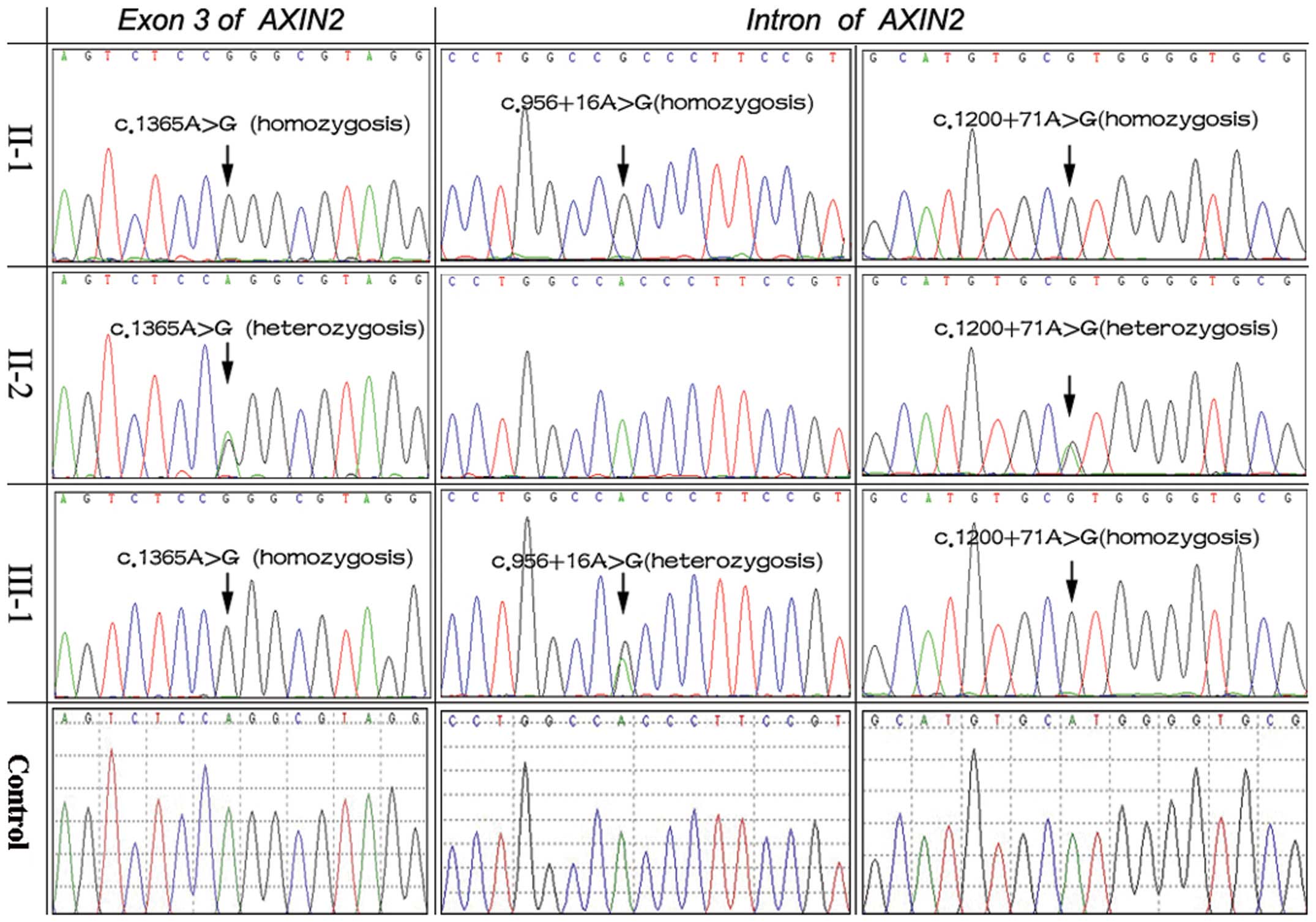|
1
|
Matalova E, Fleischmannova J, Sharpe PT
and Tucker AS: Tooth agenesis: from molecular genetics to molecular
dentistry. J Dent Res. 87:617–623. 2008. View Article : Google Scholar : PubMed/NCBI
|
|
2
|
Cudney SM and Vieira AR: Molecular factors
resulting in tooth agenesis and contemporary approaches for
regeneration: a review. Eur Arch Paediatr Dent. 13:297–304. 2012.
View Article : Google Scholar : PubMed/NCBI
|
|
3
|
Lammi L, Arte S, Somer M, et al: Mutations
in AXIN2 cause familial tooth agenesis and predispose to colorectal
cancer. Am J Hum Genet. 74:1043–1050. 2004. View Article : Google Scholar : PubMed/NCBI
|
|
4
|
Swinnen S, Bailleul-Forestier I, Arte S,
et al: Investigating the etiology of multiple tooth agenesis in
three sisters with severe oligodontia. Orthod Craniofac Res.
11:24–31. 2008. View Article : Google Scholar : PubMed/NCBI
|
|
5
|
Jia S, Zhou J, Gao Y, et al: Roles of Bmp4
during tooth morphogenesis and sequential tooth formation.
Development. 140:423–432. 2013. View Article : Google Scholar :
|
|
6
|
Bailleul-Forestier I, Molla M, Verloes A
and Berdal A: The genetic basis of inherited anomalies of the
teeth: Part 1. Clinical and molecular aspects of non-syndromic
dental disorders. Eur J Med Genet. 51:273–291. 2008. View Article : Google Scholar : PubMed/NCBI
|
|
7
|
Wang J, Jian F, Chen J, et al: Sequence
analysis of PAX9, MSX1 and AXIN2 genes in a Chinese oligodontia
family. Arch Oral Biol. 56:1027–1034. 2011. View Article : Google Scholar : PubMed/NCBI
|
|
8
|
Bergendal B, Klar J, Stecksén-Blicks C, et
al: Isolated oligodontia associated with mutations in EDARADD,
AXIN2, MSX1, and PAX9 genes. Am J Med Genet A. 155:1616–1622. 2011.
View Article : Google Scholar
|
|
9
|
Gunbay T, Koyuncu BO, Sipahi A, et al:
Multidisciplinary approach to a nonsyndromic oligodontia patient
using advanced surgical techniques. Int J Periodontics Restorative
Dent. 31:297–305. 2011.PubMed/NCBI
|
|
10
|
Nakatomi M, Wang XP, Key D, et al: Genetic
interactions between Pax9 and Msx1 regulate lip development and
several stages of tooth morphogenesis. Dev Biol. 340:438–449. 2010.
View Article : Google Scholar : PubMed/NCBI
|
|
11
|
De Coster PJ, Marks LA, Martens LC and
Huysseune A: Dental agenesis: genetic and clinical perspectives. J
Oral Pathol Med. 38:1–17. 2009. View Article : Google Scholar
|
|
12
|
Letra A, Menezes R, Granjeiro JM, et al:
AXIN2 and CDH1 polymorphisms, tooth agenesis, and oral clefts.
Birth Defects Res A Clin Mol Teratol. 85:169–173. 2009. View Article : Google Scholar :
|
|
13
|
Mostowska A, Biedziak B and Jagodzinski
PP: Axis inhibition protein 2 (AXIN2) polymorphisms may be a risk
factor for selective tooth agenesis. J Hum Genet. 51:262–266. 2006.
View Article : Google Scholar : PubMed/NCBI
|
|
14
|
Liang J, Song G, Li Q, et al: Novel
missense mutations in PAX9 causing oligodontia. Arch Oral Biol.
57:784–789. 2012. View Article : Google Scholar : PubMed/NCBI
|
|
15
|
Vieira AR: Oral clefts and syndromic forms
of tooth agenesis as models for genetics of isolated tooth
agenesis. J Dent Res. 82:162–165. 2003. View Article : Google Scholar : PubMed/NCBI
|
|
16
|
Zhang YD, Chen Z, Song YQ, et al: Making a
tooth: growth factors, transcription factors, and stem cells. Cell
Res. 15:301–316. 2005. View Article : Google Scholar : PubMed/NCBI
|
|
17
|
Amen M, Liu X, Vadlamudi U, et al: PITX2
and β-catenin interactions regulate lef-1 isoform expression. Mol
Cel Biol. 27:7560–7573. 2007. View Article : Google Scholar
|
|
18
|
Kangas AT, Evans AR, Thesleff I, et al:
Nonindependence of mammalian dental characters. Nature.
432:211–214. 2004. View Article : Google Scholar : PubMed/NCBI
|
|
19
|
Küchler EC, Lips A, Tannure PN, et al:
Tooth agenesis association with self-reported family history of
cancer. J Dent Res. 92:149–155. 2013. View Article : Google Scholar
|
|
20
|
Paixao-Cortes VR, Braga T, Salzano FM, et
al: PAX9 and MSX1 transcription factor genes in non-syndromic
dental agenesis. Arch Oral Biol. 56:337–344. 2011. View Article : Google Scholar
|
|
21
|
Menezes R, Marazita ML, Goldstein McHenry
T, et al: AXIS inhibition protein 2, orofacial clefts and a family
history of cancer. J Am Dent Assoc. 140:80–84. 2009. View Article : Google Scholar : PubMed/NCBI
|
|
22
|
Ruhin-Poncet B, Ghoul-Mazgar S, Hotton D,
et al: Msx and dlx homeogene expression in epithelial odontogenic
tumors. J Histochem Cytochem. 57:69–78. 2009. View Article : Google Scholar :
|
|
23
|
Kapadia H, Mues G and D’Souza R: Genes
affecting tooth morphogenesis. Orthod Craniofac Res. 10:105–113.
2007. View Article : Google Scholar : PubMed/NCBI
|
|
24
|
Ovári G, Molnár B, Tarján I, et al: Gene
polymorphisms in periodontitis and hypodontia: methodological basis
of investigations. Fogorv Sz. 100:266–272. 259–265. 2007.PubMed/NCBI
|
|
25
|
Townsend G, Bockmann M, Hughes T, et al:
Genetic, environmental and epigenetic influences on variation in
human tooth number, size and shape. Odontology. 100:1–9. 2012.
View Article : Google Scholar
|
|
26
|
Wang J and Abate-Shen C: Transcriptional
repression by the Msx1 homeoprotein is associated with global
redistribution of the H3K27me3 repressive mark to the nuclear
periphery. Nucleus. 3:155–161. 2012. View Article : Google Scholar : PubMed/NCBI
|
|
27
|
Pani SC: The genetic basis of tooth
agenesis: basic concepts and genes involved. J Indian Soc Pedod
Prev Dent. 29:84–89. 2011. View Article : Google Scholar : PubMed/NCBI
|
|
28
|
dos Pinheiro RS, Otero RA, Portela MB and
Castro GF: Severe oligodontia and dental anomalies in a child with
a history of multiple natal teeth: An eight-year retrospective. Gen
Dent. 59:e248–e250. 2011.
|
|
29
|
Bural C, Oztas E, Ozturk S, et al:
Multidisciplinary treatment of non-syndromic oligodontia. Eur J
Dent. 6:218–226. 2012.PubMed/NCBI
|













